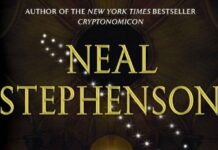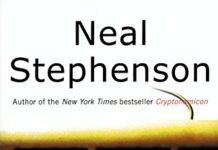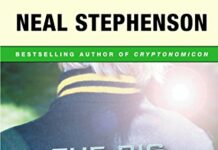
Ebook Info
- Published: 2008
- Number of pages: 1083 pages
- Format: Epub
- File Size: 0.98 MB
- Authors: Neal Stephenson
Description
Anathem, the latest invention by the New York Times bestselling author of Cryptonomicon and The Baroque Cycle, is a magnificent creation: a work of great scope, intelligence, and imagination that ushers readers into a recognizable — yet strangely inverted — world.
Fraa Erasmas is a young avout living in the Concent of Saunt Edhar, a sanctuary for mathematicians, scientists, and philosophers, protected from the corrupting influences of the outside “saecular” world by ancient stone, honored traditions, and complex rituals. Over the centuries, cities and governments have risen and fallen beyond the concent’s walls. Three times during history’s darkest epochs violence born of superstition and ignorance has invaded and devastated the cloistered mathic community. Yet the avout have always managed to adapt in the wake of catastrophe, becoming out of necessity even more austere and less dependent on technology and material things. And Erasmas has no fear of the outside — the Extramuros — for the last of the terrible times was long, long ago.
Now, in celebration of the week-long, once-in-a-decade rite of Apert, the fraas and suurs prepare to venture beyond the concent’s gates — at the same time opening them wide to welcome the curious “extras” in. During his first Apert as a fraa, Erasmas eagerly anticipates reconnecting with the landmarks and family he hasn’t seen since he was “collected.” But before the week is out, both the existence he abandoned and the one he embraced will stand poised on the brink of cataclysmic change.
Powerful unforeseen forces jeopardize the peaceful stability of mathic life and the established ennui of the Extramuros — a threat that only an unsteady alliance of saecular and avout can oppose — as, one by one, Erasmas and his colleagues, teachers, and friends are summoned forth from the safety of the concent in hopes of warding off global disaster. Suddenly burdened with a staggering responsibility, Erasmas finds himself a major player in a drama that will determine the future of his world — as he sets out on an extraordinary odyssey that will carry him to the most dangerous, inhospitable corners of the planet . . . and beyond.
User’s Reviews
Review [R]avishingly brilliant, outrageously ambitious…Stephenson embarks on a mission of world-building, and he is thoroughly successful at it.” From Publishers Weekly In this follow-up to his historical Baroque Cycle trilogy, which fictionalized the early-18th century scientific revolution, Stephenson (Cryptonomicon) conjures a far-future Earth-like planet, Arbre, where scientists, philosophers and mathematicians—a religious order unto themselves—have been cloistered behind concent (convent) walls. Their role is to nurture all knowledge while safeguarding it from the vagaries of the irrational saecular outside world. Among the monastic scholars is 19-year-old Raz, collected into the concent at age eight and now a decenarian, or tenner (someone allowed contact with the world beyond the stronghold walls only once a decade). But millennia-old rules are cataclysmically shattered when extraterrestrial catastrophe looms, and Raz and his teenage companions—engaging in intense intellectual debate one moment, wrestling like rambunctious adolescents the next—are summoned to save the world. Stephenson’s expansive storytelling echoes Walter Miller’s classic A Canticle for Leibowitz, the space operas of Larry Niven and the cultural meditations Douglas Hofstadter—a heady mix of antecedents that makes for long stretches of dazzling entertainment occasionally interrupted by pages of numbing colloquy. (Sept.) Copyright © Reed Business Information, a division of Reed Elsevier Inc. All rights reserved. –This text refers to an alternate kindle_edition edition. From AudioFile In a sanctuary in another universe, scientists, philosophers, and mathematicians are protected from the outside world. The parallels to a cloister are accentuated by the music introducing each chapter, which is reminiscent of Gregorian chant–but different. Similarly, this world is like Earth, and the culture is like Western culture on Earth–but different. A lover of wordplay, Stephenson precedes each chapter with a definition, which he reads. This book is not for the faint of heart, but William Dufris and the rest of the cast make the audiobook a good option. Dufris is stalwart in his engagement with the characters, the plot, and the development of the cosmology. He brings out the characters’ personalities and creates a sense of wonder as the complexities unfold. J.E.M. © AudioFile 2009, Portland, Maine –This text refers to an alternate kindle_edition edition. About the Author Neal Stephenson is the bestselling author of the novels Reamde, Anathem, The System of the World, The Confusion, Quicksilver, Cryptonomicon, The Diamond Age, Snow Crash, and Zodiac, and the groundbreaking nonfiction work In the Beginning . . . Was the Command Line. He lives in Seattle, Washington. –This text refers to an alternate kindle_edition edition. From the Inside Flap For ten years Fraa Erasmas, a young avout, has lived in a cloistered sanctuary for mathematicians, scientists, and philosophers, protected from the corrupting influences of the outside world. But before the week is out, both the existence he abandoned and the one he embraced will stand poised on the brink of cataclysmic change–and Erasmas will become a major player in a drama that will determine the future of his world, as he follows his destiny to the most inhospitable corners of the planet . . . and beyond.Anathem is the latest miraculous invention by the New York Times bestselling author of Cryptonomicon and The Baroque Cycle–a work of astonishing scope, intelligence, and imagination. –San Francisco Chronicle on ANATHEM –This text refers to an alternate kindle_edition edition.
Reviews from Amazon users, collected at the time the book is getting published on UniedVRG. It can be related to shiping or paper quality instead of the book content:
⭐ The book admittedly starts slow, and getting used to the invented language seems absurd when you first start. Mr. Stephenson takes a few hundred pages to set up his protagonist and core group of characters, building their world that is in seclusion from the rest of the world they live in. This is the part that a lot of the low reviews seem to give up.Once you hit the point the seclusion breaks down and the protagonist is headed out into the world, though, it kicks into the kind of speed that Neal Stephenson is known for. The rest of the book blazes past as the young Raz is put through trial after trial. The final two chapters I simply couldn’t put the book down. it was that kind of entertaining. You forget all about the language replacements and the place the story started.Readers should be cautioned that at many, many points characters break into Socratic dialogues on various subjects. Many of these topics return later to be re-dialogued with new information, or the subject matter actually plays out in the story. if you don’t like reading about people talking at length about complex ideas, you may not like portions of this novel. If you are annoyed that this novel’s invented language seems like a copy paste replacement of key words instead of a genuine language, well I think that’s a valid critique but I wasn’t as bothered by it.However if you are intrigued by the theories behind multiple universes, convergent universes, spaceflight, logic puzzles you will find all of them represented well in this novel. If you just want a neat science fiction novel with a grand adventure across continents and elsewhere, this could be your book.Like many of the 1 star reviews I didn’t give this book the chance it deserved the first time I tried to read it. My second attempt though, I thoroughly enjoyed it. Give it a go, maybe you’ll love it too.
⭐ Of all the books I read this year, I regret this one the most. The excellent reviews had me hoping it was going somewhere more exciting or was about to plumb new philosophical depths, but it did neither. It stayed remarkably boring and implausible (and I don’t mean in a quantum mechanics sense, but usually just in the way that characters act and interact with one another) for all of its many pages. I like fantasy. I like deep novels. I thought the many good reviews meant this would be a great read, so I pushed through to the end. It was terrible, right up to the last page…
⭐ Often, I am embarrassed to admit at not finishing the book, but here I had to drop it. It just doesn’t flow, it is not fun and nothing made any sense. Characters are also ill-defined and just not interested. Sorry, Neal 🙁
⭐ This book blew my mind.Filled with mind bending philosophical questions, discussions and debates. Built in a fantastically complex yet very cohesive and coherent universe. I loved the characters, the storytelling… I loved everything about this book. It instantly became one of my favourite books ever.The story is slow and this is nowhere near what I would call “action packed”… but it made me think and reflect like very few books have.I loved this book and I wish I could be more eloquent in describing it. But I will definitely be reading it again.
⭐ For a retired mathematics and computer science professor this book was a perfect fit. I seek out references to mathematics in sci-fi, but this time I was immersed in a tale whose heroes and heroines were the experts on directed acyclic graphs, the Pythagorean Theorem, a pictorial proof of which actually appears in the book, symmetry groups and all things mathematical. As the story progresses, the references to computer science and quantum theory made it even better. Although these facts are woven into the story, it is apparent that Stephenson is not just fudging it, he knows his science well. The world he creates is an extremely interesting place to be during the telling of this tale. The only problem is that the details of monastic life, of cosmology, of mathematics, of logic, of philosophy, of physics, of space mechanics, all seemed somehow to have their own separate rooms in his world.
⭐ A number of friends who shared my enjoyment of Snowcrash and The Diamond Age warned me away from this one because it was “really different”. It is, but it’s certainly the same voice. I finally had enough time to catch up on my “to read” stack and this one was close enough to the top that I got to it. By a quarter of the way into the book I was completely hooked and now I’m having trouble putting it down. It starts more slowly than Snowcrash and The Diamond Age, and yes, it assumes you’re reasonably conversant in high school math and physics and that you’ve got some understanding of how Catholic convents and monasteries work. With those basics, Stevenson spins out a captivating tale about what is, what might be, and how we know. I’m 75% of the way through and I’ve got some hunches about where it’s going. I’m excited to find out how close I’ve come.
⭐ I gave up ~70% of the way through this one. Just when it got semi-interesting that things would start to happen, the main character again ended up in pages and pages of philosophical discussions with the authors made up glossary. Exhausting. Read the synopsis of how the rest of it turns out and glad I stopped. Don’t see how this book has high ratings.
⭐ This is one of my all-time favorite books. It starts off a little slow, but you have to be able to appreciate that it’s a slow build to a fascinating and thought-provoking story set in a universe that Stephenson clearly put a tremendous amount of time and research into constructing. While this book doesn’t rival some of Stephenson’s other more well-known titles like Snow Crash in terms of pace and action, it’s nonetheless a completely engrossing read. I’ve probably read this book cover-to-cover no fewer than five times, and still every time I open it something else “clicks” that didn’t before, and as I come to understand more of the “theorics” studied by the protagonists in the book, I come to appreciate more and more just how complex the setting and story are. The size and subject matter might seem a little intimidating to casual readers at first, but I definitely recommend just committing and seeing where you go – the ride is a lot of fun.
⭐ AnanthemBy Neal StephensonThis book was recommended by my son Tj. His recommendation came with a general commentary that within it comes a moral code that he can identify with. It is a classic sci-fi involving the cosmos and numerous civilizations, where one alien civilization is in search of a natural resource, lost on their own planet, but found on a new planet. Hence the over arching dilemma of the rule of scarcity prevails. The setting of the story takes place on what would be presumed as future Earth, Stephenson eventually gives it a different name Arbre. Laced through the book are definitions of words inclusive of an epistemology that the reader must learn. These definitions build on each other in order to construct Stephenson’s moral code that has no bias to our history. However the effort is thinly veiled rendering the effort as obviously taking his own stand on philosophy. Which is oneness of societies. None the less the reader should be ware to learn the definitions them as you go. In doing so you get Stephensons moral message in a very entertaining way. It would not be a sci-fi without a moral message involving multiple civilizations.In one sentence: this book is about consciousness and cognition at brain, social and cosmos level rendering our thoughts with semantic content over and above the ones and the zeros, the black and the white that seem to define our thinking at theoric levelThis book is a tale of two philosophies coming together to save themselves from destruction. One magisterium is the Saecular Power. The other is the Mathic World – in joining hands for sake of survival, thee two are well – running the world? In shaping this dichotomy there is a theme of multiple upheavals in the history of man, that would amalgamate a set of rules for which peoples of certain Praxes and Concents (Stephenson defined terms) would abide by. Generational learning that is somewhat parallel to tradition, only with a mathematical line of reasoning. Stephenson layers the civilizations first on earth and then about two thirds of the way through the book he adds a new dimension; aliens from the cosmos. The prime characters hale from what is defined as a math. Maths take on every characteristic of a monastery, turning the common dichotomy of religion and science upside down whereby the main characters adopt the look and feel of a monk. The catch is monasteries and these monks in particular are science oriented with everything being mathematically explained. This explains my son who holds a Masters In Quantative Analysis, and a love for the book. While Math Monks live a reclusive life, seeing the outside world once every ten years, these main characters are expelled, or really sent out on a mission to save their world. The reader has to read 250 pages of life in a monastery to get to the next layer of intrigue, which is how well they survive in the outside world with common civilization as their allies and at times secular foes.Si-Fi’s usually have a quest so Stephenson uses a quest over the north pole to shape the alliance of Maths, and common folks. And then the plot turns on a dime with the smashing of giant rod into the earth, killing who up to then was the key protagonist and mentor to all those of the math. Orolo like Gandalf in Lord of the Rings is vanquished; meanwhile his ‘math (philosophy)’ lives on in the minds of the ‘math monks’. Now they in alliance with Arbre’s outside civilization, the mystery of Orlo’s movements and mission becomes real clear to the reader. Arbre has been invaded by an alien spaceship hovering above. The key word in the story is hovering and not orbiting, as that point gives the Arbrelings a strategic advantage that makes no logical sense to a reader who does not appreciate the finer points of the time & space part of earth science. A puzzle within a puzzle. That person puzzles over this fun fact only after finishing the last 300 pages of the book. The law of physics and time spins around objects in motion.So the strategy to foil the alien ship’s attack on Arbre involves objects in motion, and the concept of space time. It would be rude of me to go in to detail but suffice it to say that there is an incident that occurs in the planet saving mission that at the closing of the book, has the reader searching back to those critical pages for an explanation. Entwined with this explanation, is the thread of Stephenson’s philosophy and moral message. Alter realities are a theme of this book and in fact the alter reality or parallel plane exists through Jad in the end, where he lives and is a hero but in reality he dies. It involves time, space, and Oneness of the Universe and a Hylean Flow of consciousness through a Wick that transcends cosmi. All are intriguing subjects to me.Consciousness: “All it needs to do is to perceive – to reflect- the cosmos that it’s really in, as it really is.” This is the theme of my book of poems. And a quote from a recently read book, How Yoga Works: “all things are themselves by themselves” for you to awaken to. Oddly and still coincidently here again vouches the phrase. Seek and ye shall find” … in everyplace you look …even if coincidently.My favorite metaphor: I am tormented, or tantalized, by the sense that I’m almost in view of something that is at the limit of my comprehension. I dream of being in the sea, treading water, trying to see a beacon on shore. But the view is blocked by the crests of the waves. Sometimes, when conditions are perfect, I can pop up high enough to glimpse it. But then, before I can form any form impression of what it is I’m seeing, I sink back down of own weight, and get slapped in the face by another wave.On My blog Cigar Room of Books, keyword cigarroomofbooks, I have a bibliography of excerpts that shaped my review. I invite to to check it out and comment
⭐ Plato meets modern cosmology/quantum mechanics half way in the middle ages or actually in a monastic setting on an Earth like world. I agree with many reviewers that the philosophy, which is warmed over Plato, is dull and can be safely skimmed. Later in the book there are long winded expositions of the Multiverse which can also be skimmed until about 85% through the book. At this point the reader will have to pay close attention to the ideas or they will miss the very quick and fast paced closing. With respect to the pace of the book, I did not mind the slow development in the first half of the book, and I was almost put off by the mad cap adventures in the second half. I gave the book 5 stars because of the many interesting and inventive ideas throughout the book. It was an entertaining read.
Keywords
Free Download Anathem in Epub format
Anathem Epub Free Download
Download Anathem 2008 Epub Free
Anathem 2008 Epub Free Download
Download Anathem Epub
Free Download Ebook Anathem




